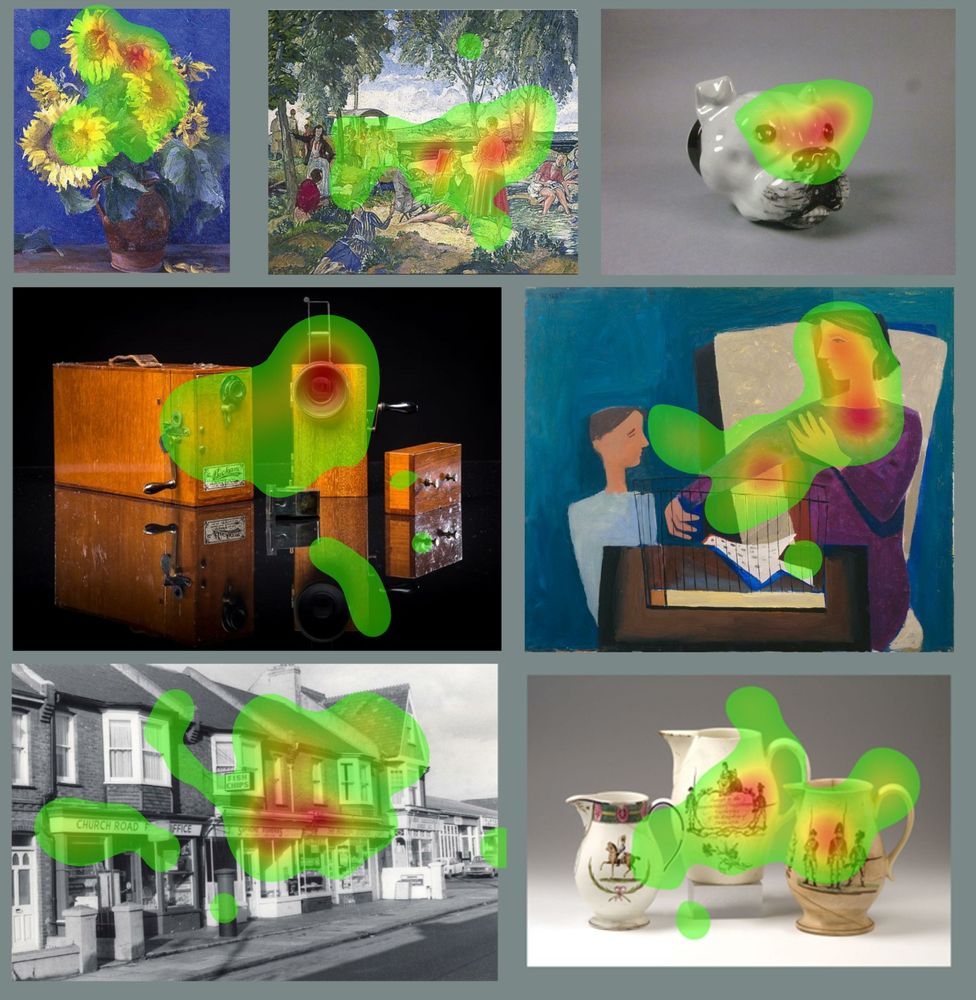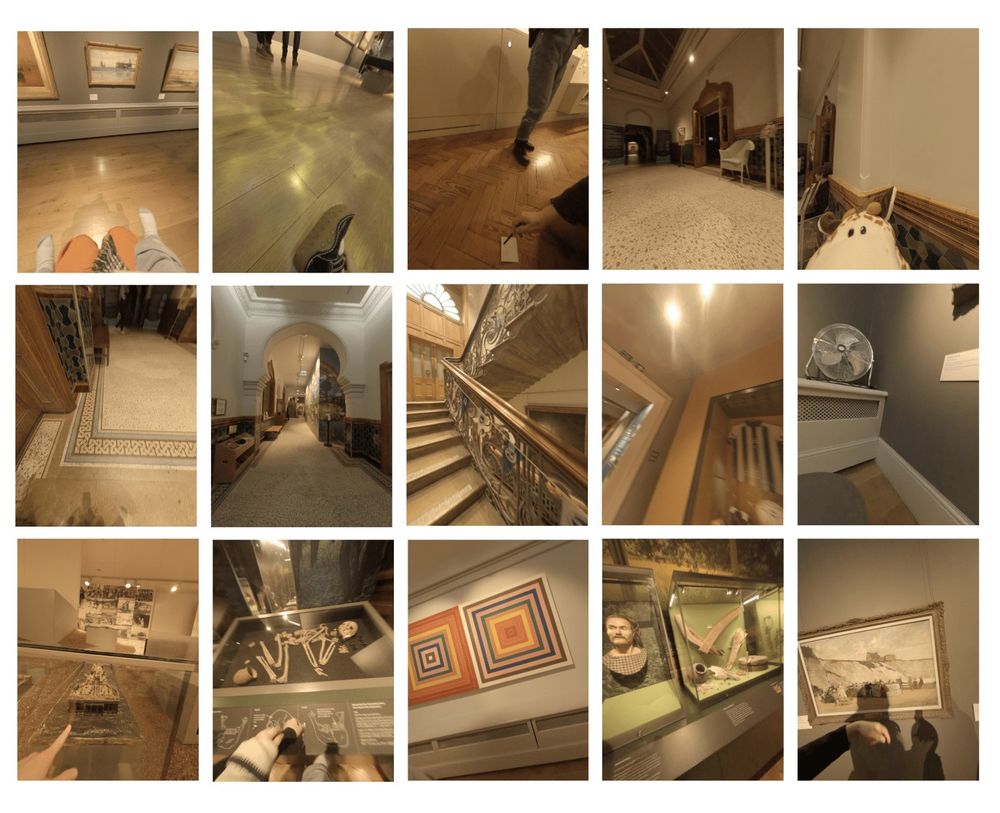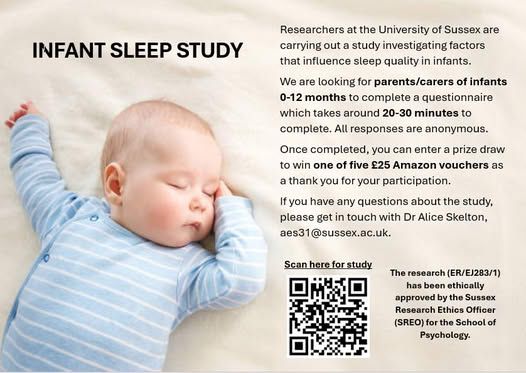We'd love to talk to more museums and galleries about how babies experience your exhibits, so get in touch (obviously I am keen to try to get @themerl.bsky.social on board 🐑👀👶)
22.03.2025 22:09 — 👍 0 🔁 0 💬 0 📌 0

Top to bottom images are: Sunflowers by Gertrude Fawcett; The Sketching Party by Gerald Edward Moira; Cup by Henry Willett; BioKam by Alfred Darling; Girl and a Birdcage by William Scott; Photographic Print; Jug by Wedgewood, all at Brighton Museum & Art Gallery. From these heatmaps we can see what captures babies’ gaze. For example, we can see that babies look longest at high contrast areas (centre of sunflowers, the lens on the camera, the neckline of the female figure, the edge of windows and lettering in the photo); colourful areas (the red figure by the lake, the colourful top and blue background in Girl and a Birdcage); gloss (the table reflecting BioKam); curves (the round lens of BioKam, the outline of the sunflowers, the curved signage in the photo, and the handles of the jugs); and faces (even when they are not human as with the dog Jug). Baby eye-movement heat maps provided by The Sussex Baby Lab
And here are some very fun heat maps of what babies like to look at in exhibits and paintings, nicely showing baby preferences for things like roundness & contour, shiny bits, high colour and luminance contrast, and faces.
22.03.2025 22:09 — 👍 3 🔁 0 💬 1 📌 0

Seeing a museum from the baby point of view. Images collected by Sussex Baby Lab, recorded with cameras mounted on babies’ heads whilst visiting Brighton Museum and Art Gallery. Top row: Uniquely baby view points: How babies see the gallery will depend on their mode of transport. Babies in a sling will see the world from a similar point of view as their caregivers, while babies who are walking or in prams will spend a lot of time on the floor or seeing the world from a lower point of view. Other things might be vying for babies attention when they’re in the space! Middle row: babies’ attention will be captured by unintentional things like the architecture of the building, bright lights, and non exhibit objects (e.g. the fan which is curved and shiny – doubly exciting!). Moving between exhibits or galleries often means being in corridors – to keep babies engaged, providing something visually interesting for them to look at while they are transitioning between spaces is helpful. Bottom row: exhibits provide lots of opportunities for sharing a moment with their caregiver, especially when their caregiver is interacting in some way with an exhibit. Babies will seek out, look, and interact with the exhibits at museums, and they give lots of opportunity for them to practice their developing visual skills.
Our Babies in Museums resource, created with Kids in Museums, is now available! It explores how babies see & think in museums & ways of making spaces welcoming for them & their caregivers. Here are some shots from our baby head cam visitors to Brighton Museum kidsinmuseums.org.uk/resources/ba...
22.03.2025 22:09 — 👍 3 🔁 1 💬 1 📌 0
(last year at this point in the term we had 114 responses, this year we're at 24 - so help and good vibes are much appreciated!)
25.02.2025 17:31 — 👍 0 🔁 0 💬 0 📌 0

Some of my great UG dissertation students are collecting data on what impacts infant sleep. We usually rely on fb ads for recruitment, but it's been a little...quiet... out there! Please ask any babies you know 0-12 months to share this questionnaire with their caregivers tinyurl.com/babysnooze25
25.02.2025 17:31 — 👍 2 🔁 0 💬 1 📌 0
Post-doc position available from Sept 2025 for 18 months on a @leverhulme.bsky.social project into children's perceptual decision-making using diffusion models. Closes 10th March. Pls share! edzz.fa.em3.oraclecloud.com/hcmUI/Candid... #VisionScience #PsychSciSky
24.02.2025 12:59 — 👍 9 🔁 17 💬 0 📌 1
At the Sussex Researcher School we support our emerging researchers: Junior Research Associates (JRAs), Postgraduate Researchers (PGRs) & Early Career Researchers (ECRs).
PGRs: @SussexPGRs.bsky.social
ECRs: Coming soon
Part of the University of Sussex.
Raised on Coast Miwok land, longtime resident on Ramaytush Ohlone land, writer, climate person, feminist, wanderer. Just started a newsletter at MeditationsInAnEmergency.com.
🧠🎨
neuroaesthetics.med.upenn.edu
UK-based freelance Museum Learning Consultant
➕ Maths communication & teaching
🏛️ Museum Learning & education
🌐 TeaKayB.mathsy.space
🕸️ @TeaKayB.mathstodon.xyz.ap.brid.gy
🛜 Check my starter packs & feeds!
#MathsInMuseums #MuseumEd #MathsJam
Ecological Psychology | Phil of CogSci | Developmental Psychology
Developmental scientist at UEA , psycholinguist, computational modelling, infant studies, eye tracking
Principal of NSPC, existential psychotherapist, counselling psychologist. Passionate about maternal mental health and ecopsychology.
Professor of AI, Deputy VC & Provost. Views my own.
https://linktr.ee/michaelluck
The MERL, Uni of Reading. We explore the history of the English countryside and its people. Chaotic Good.
https://merl.reading.ac.uk/
News and Announcements from the BPS Developmental Psychology Section. Please also check out our website: https://www.bps.org.uk/member-networks/developmental-psychology-section
Open-source statistics program that is free, friendly, & flexible.
Armed with an easy-to-use GUI, we enable both classical & Bayesian analyses.
https://jasp-stats.org/
Testimonials: https://jasp-stats.org/alltestimonials/
The Lancaster International Conference on Infant and Early Child Development. Aug 27-29, 2025
An independent charity that seeks to fund blue skies research and scholarship. Follow this channel for details on upcoming grant deadlines, published research, scheme opening dates, grant announcements, events, and more. https://www.leverhulme.ac.uk/
Real Science, from Real Scientists and other STEAMM Professsionals. Migrating from the other place.
This week: BlackMammalogists Week with @blackmammalogists.bsky.social https://blackmammalogists.com/
Professor of Developmental Psychology at Ulster Uni.
Reporting research on human behavior and cognition. #PsychSciSky #Psychology #SciComm
Welcome to the home of human ingenuity. We curate a world-renowned collection & organise exhibitions and events for over 3 million visitors a year. Read our community guidelines: https://www.sciencemuseumgroup.org.uk/smg-social-media-community-guidelines
We’re the museum looking deeper into the Earth’s past to shape a new future where both people and planet thrive.
Protecting the planet, it’s in our nature. 🌍
Assoc Prof in Psych at Durham Uni. Infancy, word learning and cognition. Sometime cellist and conductor.



